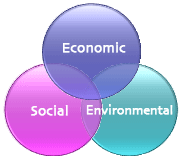
Logic
We have noticed that as countries strive to achieve sustainable building standards, the focus is mostly on the environmental aspect. There are, however, three pillars of sustainability, not just one. Throughout our project, we have considered the social aspect, making the building more hospitable for the users. We feel with increasing building standards, classrooms have the tendency to overheat. This will only be exacerbated by increasing ICT use. The foundation for our hypotheses and assumptions are based on the documents referenced in our literature review.

Figure 1: The Three Pillars of Sustainability
Hypotheses
Based on the logic above our hypotheses are:
- Questionnaire will show evidence of teachers' expectations of increasing technology in teaching methods
- Advanced standard schools with natural ventilation will overheat with increasing ICT (to be proven with an ESP-r Model)
General Assumptions
- Increasing Information & Communication Technology in the classroom
- ICT energy consumption reduction trends
- Increasing building standards
- Individually assigned ICT
- Teaching methods more technologically reliant
Addressing Overheating
There are three ways to address the issue of overheating:Absorb
Absorbtion can be done through thermal massing or the use of phase-changing materials (PCMs). There are some negative aspects to this solution, however. Thermal massing with either concrete or trombe walls, have lag time, rendering controlibility of thermal comfort becomes ineffective. Design implications, such as thicker walls or loss of views for trombe walls may also be an issue. PCMs bring other concerns. According to a presentation from an Aerospace Engineering student at the University of Colorado, PCMs are corrosive, toxic and cost between $116-250 per litre.1
Eliminate
Elimination in practical terms would require the removal of all the ICT equipment that is providing extra heat into the classroom environment. Although there are a number of ways of reducing heat, for example cloud computing, it is our opinion that these methods fall under the diminish category, which is discussed below in greater detail. It is therefore our opinion that elimination is very unlikely as our research indicates that the classroom is becoming more and more reliant on ICT equipment and that teachers and pupils are beginning to expect a more digitally enhanced learning environment. Removing this technology from the classroom would leave the pupil at a disadvantage in this modern age.
Diminish
Diminishing the heat caused by increased ICT usage within the classroom seems to be the most viable and diverse option to our group. Not only did this option still allow full usage of increasing amounts of computing equipment, but it would also tackle the inherent problem of overheating caused by this increased usage. Our study focused on a number of areas, mainly how future energy trends in ICT equipment would impact overheating problems experienced. Our investigation also examined simple changes, such as lowering heating set points, etcetera, that could also have an impact on overheating, all of which can be found within this website.
1. Mottinger, B. (1999) Phase Change Materials (PCMs) and Applications. [presentation] University of Colorado: Aerospace Engineering.








